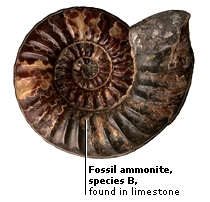DK Science: Dating Fossils
The Age of Dinosaurs was so many millions of years ago that it is very difficult to date exactly. Scientists use two kinds of dating techniques to work out the age of rocks and fossils. The first method is called relative dating. This considers the positions of the different rocks in sequence (in relation to each other) and the different types of fossil that are found in them. The second method is called absolute dating and is done by analysing the amount of radioactive decay in the minerals of the rocks.
Scientists find out the age of a dinosaur fossil by dating not only the rocks in which it lies, but those below and above it. Sometimes, scientists already know the age of the fossil because fossils of the same species have been found elsewhere and it has been possible to establish accurately from those when the dinosaur lived. Geologists call this the principle of lateral continuity. A fossil will always be younger than fossils in the beds beneath it and this is called the principle of superposition.
In an undisturbed sequence of rocks, such as in a cliff face, it is easy to get a rough idea of the ages of the individual strata – the oldest lies at the bottom and the youngest lies at the top. This is because new sediments are always laid down on top of sediments that have already been deposited. So, when looking at the history of a cliff face, it is important to read the story it tells from the bottom layer up.
Index fossils are fossils that can be used to date the rock in which they are found. The best examples are fossils of animals or plants that lived for a very short period of time and were found in a lot of places. Ammonites, shelled relatives of today’s octopus, make ideal index fossils. Suppose a dinosaur fossil has been found in the beds of an ancient delta (the mouth of a river leading to the sea). The sediment of this area was laid down after ammonite A appeared 199 million years ago, and before ammonite B became extinct 195 million years ago. This narrows the date of the delta beds to the four million years between these dates.
There are some radioactive elements in rock that decay by giving off energy and turning into different, more stable elements. This radioactive decay takes place at a constant rate for each radioactive element. Scientists know exactly how long it will take for half the quantity of the element to change, and this state is known as its half-life. After another half-life has passed, the element will have decayed to a quarter of its original amount. After another half-life has passed, it will have decayed to an eighth, and so on.
A good example of this is potassium-argon dating. The half-life of potassium-40 is 1,310 million years, after which half of its substance will have changed into stable argon-40.
To order this book direct from the publisher, visit DK's website.



